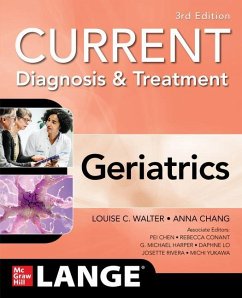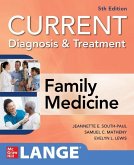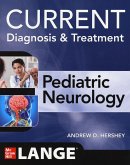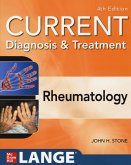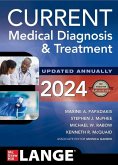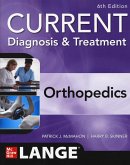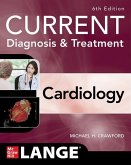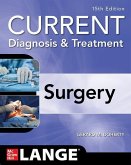- Broschiertes Buch
- Merkliste
- Auf die Merkliste
- Bewerten Bewerten
- Teilen
- Produkt teilen
- Produkterinnerung
- Produkterinnerung
Publisher's Note: Products purchased from Third Party sellers are not guaranteed by the publisher for quality, authenticity, or access to any online entitlements included with the product. The highly rated geriatrics guide has been updated and streamlined, getting you up to speed on everything you need to know-quickly and efficiently One of the top-selling geriatrics guides in medicine, Current Diagnosis & Treatment:Geriatrics now covers the unique challenges clinicians are facing today,such as policies concerning special populations, care in collaboration with teams, and working within…mehr
Andere Kunden interessierten sich auch für
![CURRENT Diagnosis & Treatment in Family Medicine CURRENT Diagnosis & Treatment in Family Medicine]() Jeannette South-PaulCURRENT Diagnosis & Treatment in Family Medicine108,99 €
Jeannette South-PaulCURRENT Diagnosis & Treatment in Family Medicine108,99 €![CURRENT Diagnosis and Treatment Pediatric Neurology CURRENT Diagnosis and Treatment Pediatric Neurology]() Andrew HersheyCURRENT Diagnosis and Treatment Pediatric Neurology122,99 €
Andrew HersheyCURRENT Diagnosis and Treatment Pediatric Neurology122,99 €![Current Diagnosis & Treatment in Rheumatology, Fourth Edition Current Diagnosis & Treatment in Rheumatology, Fourth Edition]() John StoneCurrent Diagnosis & Treatment in Rheumatology, Fourth Edition93,99 €
John StoneCurrent Diagnosis & Treatment in Rheumatology, Fourth Edition93,99 €![Current Medical Diagnosis and Treatment 2024 Current Medical Diagnosis and Treatment 2024]() Maxine PapadakisCurrent Medical Diagnosis and Treatment 2024101,99 €
Maxine PapadakisCurrent Medical Diagnosis and Treatment 2024101,99 €![CURRENT Diagnosis & Treatment Orthopedics, Sixth Edition CURRENT Diagnosis & Treatment Orthopedics, Sixth Edition]() Patrick McMahonCURRENT Diagnosis & Treatment Orthopedics, Sixth Edition123,99 €
Patrick McMahonCURRENT Diagnosis & Treatment Orthopedics, Sixth Edition123,99 €![Current Diagnosis & Treatment Cardiology, Sixth Edition Current Diagnosis & Treatment Cardiology, Sixth Edition]() Michael CrawfordCurrent Diagnosis & Treatment Cardiology, Sixth Edition100,99 €
Michael CrawfordCurrent Diagnosis & Treatment Cardiology, Sixth Edition100,99 €![Current Diagnosis and Treatment Surgery Current Diagnosis and Treatment Surgery]() Gerard DohertyCurrent Diagnosis and Treatment Surgery131,99 €
Gerard DohertyCurrent Diagnosis and Treatment Surgery131,99 €-
-
-
Publisher's Note: Products purchased from Third Party sellers are not guaranteed by the publisher for quality, authenticity, or access to any online entitlements included with the product. The highly rated geriatrics guide has been updated and streamlined, getting you up to speed on everything you need to know-quickly and efficiently One of the top-selling geriatrics guides in medicine, Current Diagnosis & Treatment:Geriatrics now covers the unique challenges clinicians are facing today,such as policies concerning special populations, care in collaboration with teams, and working within healthcare systems. Presented by a top-ranked group of internationally renowned experts, this concise and authoritative guide delivers everything you need to know about assessment, care, conditions, diseases, and symptoms of geriatric patients; provides a new focus on policy, society, and the global environment;and includes new chapters on assisted-living settings, HIV and aging, and aid in dying.
Hinweis: Dieser Artikel kann nur an eine deutsche Lieferadresse ausgeliefert werden.
Hinweis: Dieser Artikel kann nur an eine deutsche Lieferadresse ausgeliefert werden.
Produktdetails
- Produktdetails
- Verlag: McGraw-Hill Education
- 3 ed
- Seitenzahl: 736
- Erscheinungstermin: 25. November 2020
- Englisch
- Abmessung: 229mm x 185mm x 32mm
- Gewicht: 1064g
- ISBN-13: 9781260457087
- ISBN-10: 1260457087
- Artikelnr.: 59645227
- Herstellerkennzeichnung
- Libri GmbH
- Europaallee 1
- 36244 Bad Hersfeld
- 06621 890
- Verlag: McGraw-Hill Education
- 3 ed
- Seitenzahl: 736
- Erscheinungstermin: 25. November 2020
- Englisch
- Abmessung: 229mm x 185mm x 32mm
- Gewicht: 1064g
- ISBN-13: 9781260457087
- ISBN-10: 1260457087
- Artikelnr.: 59645227
- Herstellerkennzeichnung
- Libri GmbH
- Europaallee 1
- 36244 Bad Hersfeld
- 06621 890
Louise Walter, MD, Professor and Chief, Division of Geriatrics, University of California San Francisco Anna Chang, MD, Professor, Division of Geriatrics, University of California San Francisco Rebecca Conant, MD, Professor, Division of Geriatrics, University of California San Francisco Pei Chen, MD, Assistant Professor, Division of Geriatrics, University of California San Francisco Daphne Lo, MD, MAEd, Assistant Professor, Division of Geriatrics, University of California San Francisco G. Mike Harper, MD, Professor, Division of Geriatrics, University of California San Francisco Josette Rivera, MD, Associate Professor, Division of Geriatrics, University of California San Francisco Michi Yukawa, MD, Professor, Division of Geriatrics, University of California San Francisco
Table of Contents
Section1. Principles of Geriatric Assessment and Care
1. Introduction to the Care of Older Persons: Knowledge, Skills & System
Change
2. Guiding Principles
3. Overview of Geriatric Assessment (6)
4. Geriatric Assessment in Primary Care
5. Teams
6. Patient Goals
7. Prognosis
8. Functional Assessment
9. Falls & Gait Impairment
10. Vision Impairment
11. Hearing Impairment
12. Dementia
13. Incontinence
14. Depression
15. Nutrition
16. Medication Use
17. Caregiver Support
18. Financial, Environmental and Social Resources
19. Abuse
20. Preventive Services
21. The Interprofessional Team (5)
22. Key Definitions & Context
23. Innovations in Geriatric Interprofessional Teams
24. Evidence for Interprofessional Teams
25. Barriers to Teamwork
26. Resources and Tools for Teamwork
27. Goals of Care and Consideration of Prognosis (3)
28. Guide to Goals of Care Discussions
29. Importance of Surrogate Decision Makers
30. Prognostication
31. Prognosis Related to Specific Diseases
32. Communicating Prognosis to Patient or Surrogate
33. Functional Assessment & Functional Decline (2)
34. Epidemiology of Functional Limitations
35. Assessment of Functional Status
36. Risk Factors for Functional Decline
37. Prevention of Functional Decline
38. Treatment of Functional Decline
39. Falls & Mobility Impairment (25)
40. Epidemiology of Falls
41. Assessment of Fall Risk and Mobility
42. Risk Factors for Falls
43. Prevention of Falls
44. Treatment of Mobility Impairment
45. Managing Vision Impairment (61)
46. Normal Changes in the Aging Eye
47. Cataracts
48. Age-Related Macular Degeneration
49. Diabetic Retinopathy
50. Glaucoma
51. Systemic Effects of Eye Medications
52. Visual Symptoms Indicating Need for Urgent Referral to an Eye-Care
Specialist
53. Managing Hearing Impairment (62)
54. Age-related Hearing Changes
55. How and when to test for Hearing Impairment
56. Sensory Hearing Impairment
57. Neural Hearing Impairment
58. Conductive Hearing Impairment
59. Treatment for Hearing Impairment
60. Cognitive Impairment & Dementia (22)
61. Age-related Cognitive Changes
62. Screening for Cognitive Impairment
63. Mild Cognitive Impairment
64. Common types of Dementia
65. Dementia-related Behaviors
66. When to refer to subspecialty care
67. Urinary Incontinence (39)
68. Age-related Urogenital Changes
69. Screening for Urinary Incontinence
70. Common Causes, Diagnosis, and Treatment of Male-Sex Urinary Incontinence
71. Common Causes, Diagnosis, and Treatment of Female-Sex Urinary Incontinence
72. Sexual Health & Dysfunction (46)
73. Age-related physiologic changes affecting sexual function
74. Taking a Sexual History
75. Sexually-transmitted Infections
76. Common Causes, Diagnosis, and Treatment of Male-Sex Sexual Dysfunction
77. Common Causes, Diagnosis, and Treatment of Female-Sex Sexual Dysfunction
78. Depression & Other Mental Health Issues (45)
79. Depression
80. Suicide
81. Bipolar Disorder
82. Anxiety & Stress Disorders
83. Schizophrenia & Psychotic Disorders
84. Defining Adequate Nutrition (68)
85. Assessment of Nutritional status in Older Adults
86. Recommendation on Essential Nutrients, Vitamins and Minerals intake
87. Definition and potential causes of involuntary weight loss
88. Obesity in older adults
89. Interaction of food and medications
90. Types of nutrition deficiencies
91. Nutrition in special populations
92. Principles of Prescribing & Adherence (9)
93. General Principles & Polypharmacy
94. Drug Metabolism & Physiologic Effects
95. Geriatric Therapeutics
96. Prescribing for Older Adults
97. Adherence
98. Intervening to Reduce Polypharmacy
99. Prescribing Across the Care Continuum
100. Addressing Multimorbidity (10)
101. Background and Definitions
102. Multimorbidity & Health Outcomes
103. Challenges to Managing Multimorbidity
104. General Considerations in the Care of Multimorbid Older Adults
105. Atypical Presentations of Illness (7)
106. Defining Atypical Presentations
107. Identifying Patients at Risk
108. Caregiving and Caregiving Support (new)
109. Defining Caregiving
110. Caregiving in Context
111. Interventions to support caregivers
112. Caregiver resources
113. Potential Outcomes from Caregiving
114. Assessing for Caregiver Burden
115. Responding to Caregiver Burden
116. The Social Context (4-delete Medicare and include legal
issues-conservatorship, etc. )
117. Financial Issues Facing Older Persons
118. Food Insecurity
119. Legal Issues & Conservatorship (new)
120. General Recommendations for Clinicians
121. Detecting, Assessing & Responding to Elder Mistreatment (72)
122. Detecting and Assessing Elder Mistreatment
123. Responding to Elder Mistreatment
124. Prevention & Health Promotion (8)
125. General Principles of Screening & Prevention in Older Persons
126. Screening for Geriatric Syndromes
127. Assessment of Health-Related Behaviors
128. Immunizations
129. Screening for Endocrine Disorders
130. Screening for Cardiovascular Disease
131. Cancer Screening
132. Ethics & Informed Decision Making (12)
133. Ethical Issues in the Care of Older Persons
134. Decision-Making Capacity & Informed Decision-Making
135. Advance Care Planning & Advance Directives
136. Surrogate Decision-Making
137. Balancing Promotion of Independence & Patient Safety
138. Geriatric Palliative Care (11)
139. General Principles
140. Psychological, Spiritual and Social Issues
141. Aid in Dying (new)
142. Challenges to Providing Palliative Care in Long-Term Care Settings
143. Caring for Family Members: Grief & Bereavement
144. Assessing Therapies for Longevity & the Biology of Aging (56-rename for
John N)
145. Add domains here
146. Applying Evidence-Based Care to Older Persons (74)
147. Challenges with Current Evidence
148. Applying the Evidence to Older Persons
Section 2: Care Settings
149. Ambulatory Care & Care Coordination (14-look at content)
150. General Principles
151. Models of Ambulatory Care
152. Care Coordination and Integration Across Health Systems and Services
153. Transitions of Care (13)
154. General Principles
155. Background & Definitions
156. Adverse Events During Transitions
157. Barriers to Successful Care Transitions
158. Evidence-Based Interventions & Best Practices
159. Innovations
160. Future of Care Transitions
161. Emergency Department Care (15)
162. General Principles
163. Mod els of Emergency Care
164. Structural Enhancements
165. Financing
166. Clinical Care
167. Future of Emergency Care
168. Hospital Care (16)
169. General Principles
170. Hazards of Hospitalization
171. Successful Models of Care
172. Approach to the Hospitalized Older Person
173. Therapy
174. Prevention
175. Transitioning from Hospital to Home
176. Perioperative Care for Older Surgical Patients (17)
177. General Principles
178. Surgical Risk in Older Persons
179. Clinical Care
180. Models of Surgical Care
181. Home-Based Care (19)
182. General Principles
183. Models of Medical House Calls (Home-Based Primary Care, Transitional Care,
Hospital at Home, Home-Based Palliative Care)
184. Models of Home Nursing & Rehabilitation
185. Eligibility Requirements & Payment Denials
186. Approach to Home Care & Assessments
187. Innovations
188. Residential Care and Assisted Living Care (new)
189. General Principles
190. Models of Residential Care and Assisted Living Care
191. Nursing Home Care & Rehabilitation (18)
192. General Principles
193. Institutional Long-Term Care
194. Short-stay Rehabilitation (new)
195. Consider Dementia locked unit care? Other domains?
196. Technology to Enhance Geriatric Care (new)
197. New technology for older adults in the community
198. New technology for older adults in institution
199. How to evaluate the efficacy and benefits of these new technology
200. Potential list of reliable sites to rate these devices or services
201. The Geriatric Care Industry
202. Safety Enhancing technology
203. Transportation Enhancing technology
Section 3: Common Conditions & Diseases inGeriatrics
204. Osteoarthritis (26)
205. Osteoporosis & Hip Fractures (27)
206. Delirium (21)
207. Parkinson's Disease & Essential Tremor (24)
208. Cerebrovascular Disease (23)
209. Coronary Artery Disease (28)
210. Acute Coronary Syndrome
211. Chronic Coronary Artery Disease
212. Heart Failure & Heart Rhythm Disorders (29)
213. Heart Failure
214. Bradyarrhythmias
215. Tachyarrhythmias-Atrial Fibrillation & Atrial Flutter
216. Ventricular Arrhythmias
217. Decision-Making about Implantable Devices (new)
218. Hypertension (30)
219. Valvular Disease (31)
220. Aortic Stenosis
221. Aortic Insufficiency
222. Mitral Stenosis
223. Mitral Regurgitation
224. Peripheral Arterial Disease & Venous Thromboembolism (32)
225. Anticoagulation (55)
226. Classes of Anticoagulant Therapy
227. Management of Bleeding in Older Persons on Anticoagulants
228. Chronic Venous Insufficiency, Stasis Ulcers & Lymphedema (33)
229. Chronic Lung Disease (replaces COPD chap 34)
230. Gastrointestinal Disease (35)
231. Gastroesophageal Reflux Disease
232. Dysphagia
233. Motility Disorders
234. Peptic Ulcer Disease
235. Dyspepsia
236. Diarrhea
237. Diverticular Disease
238. Inflammatory Bowel Disease
239. Fecal Incontinence
240. Colonic Ischemia
241. Abdominal Pain
242. Fluid & Electrolyte Abnormalities (37)
243. Hyponatremia
244. Hypernatremia
245. Hypokalemia
246. Hyperkalemia
247. Nocturnal Polyuria
248. Chr onic Kidney Disease (38)
249. Thyroid, Parathyroid & Adrenal Gland Disorders (41)
250. Subclinical Hypothyroidism
251. Subclinical Hyperthyroidism
252. Hypothyroidism & Myxedema Coma
253. Hyperthyroidism
254. Nodular Thyroid Disease & Neoplasia
255. Acute Adrenal Insufficiency
256. Cushing Syndrome
257. Hyperparathyroidism
258. Diabetes (42)
259. Anemia (43)
260. Common Cancers (44)
261. Breast Cancer
262. Lung Cancer
263. Colorectal Cancer
264. Prostate Cancer (new)
265. Pancreatic Cancer
266. Ovarian Cancer
267.
Section1. Principles of Geriatric Assessment and Care
1. Introduction to the Care of Older Persons: Knowledge, Skills & System
Change
2. Guiding Principles
3. Overview of Geriatric Assessment (6)
4. Geriatric Assessment in Primary Care
5. Teams
6. Patient Goals
7. Prognosis
8. Functional Assessment
9. Falls & Gait Impairment
10. Vision Impairment
11. Hearing Impairment
12. Dementia
13. Incontinence
14. Depression
15. Nutrition
16. Medication Use
17. Caregiver Support
18. Financial, Environmental and Social Resources
19. Abuse
20. Preventive Services
21. The Interprofessional Team (5)
22. Key Definitions & Context
23. Innovations in Geriatric Interprofessional Teams
24. Evidence for Interprofessional Teams
25. Barriers to Teamwork
26. Resources and Tools for Teamwork
27. Goals of Care and Consideration of Prognosis (3)
28. Guide to Goals of Care Discussions
29. Importance of Surrogate Decision Makers
30. Prognostication
31. Prognosis Related to Specific Diseases
32. Communicating Prognosis to Patient or Surrogate
33. Functional Assessment & Functional Decline (2)
34. Epidemiology of Functional Limitations
35. Assessment of Functional Status
36. Risk Factors for Functional Decline
37. Prevention of Functional Decline
38. Treatment of Functional Decline
39. Falls & Mobility Impairment (25)
40. Epidemiology of Falls
41. Assessment of Fall Risk and Mobility
42. Risk Factors for Falls
43. Prevention of Falls
44. Treatment of Mobility Impairment
45. Managing Vision Impairment (61)
46. Normal Changes in the Aging Eye
47. Cataracts
48. Age-Related Macular Degeneration
49. Diabetic Retinopathy
50. Glaucoma
51. Systemic Effects of Eye Medications
52. Visual Symptoms Indicating Need for Urgent Referral to an Eye-Care
Specialist
53. Managing Hearing Impairment (62)
54. Age-related Hearing Changes
55. How and when to test for Hearing Impairment
56. Sensory Hearing Impairment
57. Neural Hearing Impairment
58. Conductive Hearing Impairment
59. Treatment for Hearing Impairment
60. Cognitive Impairment & Dementia (22)
61. Age-related Cognitive Changes
62. Screening for Cognitive Impairment
63. Mild Cognitive Impairment
64. Common types of Dementia
65. Dementia-related Behaviors
66. When to refer to subspecialty care
67. Urinary Incontinence (39)
68. Age-related Urogenital Changes
69. Screening for Urinary Incontinence
70. Common Causes, Diagnosis, and Treatment of Male-Sex Urinary Incontinence
71. Common Causes, Diagnosis, and Treatment of Female-Sex Urinary Incontinence
72. Sexual Health & Dysfunction (46)
73. Age-related physiologic changes affecting sexual function
74. Taking a Sexual History
75. Sexually-transmitted Infections
76. Common Causes, Diagnosis, and Treatment of Male-Sex Sexual Dysfunction
77. Common Causes, Diagnosis, and Treatment of Female-Sex Sexual Dysfunction
78. Depression & Other Mental Health Issues (45)
79. Depression
80. Suicide
81. Bipolar Disorder
82. Anxiety & Stress Disorders
83. Schizophrenia & Psychotic Disorders
84. Defining Adequate Nutrition (68)
85. Assessment of Nutritional status in Older Adults
86. Recommendation on Essential Nutrients, Vitamins and Minerals intake
87. Definition and potential causes of involuntary weight loss
88. Obesity in older adults
89. Interaction of food and medications
90. Types of nutrition deficiencies
91. Nutrition in special populations
92. Principles of Prescribing & Adherence (9)
93. General Principles & Polypharmacy
94. Drug Metabolism & Physiologic Effects
95. Geriatric Therapeutics
96. Prescribing for Older Adults
97. Adherence
98. Intervening to Reduce Polypharmacy
99. Prescribing Across the Care Continuum
100. Addressing Multimorbidity (10)
101. Background and Definitions
102. Multimorbidity & Health Outcomes
103. Challenges to Managing Multimorbidity
104. General Considerations in the Care of Multimorbid Older Adults
105. Atypical Presentations of Illness (7)
106. Defining Atypical Presentations
107. Identifying Patients at Risk
108. Caregiving and Caregiving Support (new)
109. Defining Caregiving
110. Caregiving in Context
111. Interventions to support caregivers
112. Caregiver resources
113. Potential Outcomes from Caregiving
114. Assessing for Caregiver Burden
115. Responding to Caregiver Burden
116. The Social Context (4-delete Medicare and include legal
issues-conservatorship, etc. )
117. Financial Issues Facing Older Persons
118. Food Insecurity
119. Legal Issues & Conservatorship (new)
120. General Recommendations for Clinicians
121. Detecting, Assessing & Responding to Elder Mistreatment (72)
122. Detecting and Assessing Elder Mistreatment
123. Responding to Elder Mistreatment
124. Prevention & Health Promotion (8)
125. General Principles of Screening & Prevention in Older Persons
126. Screening for Geriatric Syndromes
127. Assessment of Health-Related Behaviors
128. Immunizations
129. Screening for Endocrine Disorders
130. Screening for Cardiovascular Disease
131. Cancer Screening
132. Ethics & Informed Decision Making (12)
133. Ethical Issues in the Care of Older Persons
134. Decision-Making Capacity & Informed Decision-Making
135. Advance Care Planning & Advance Directives
136. Surrogate Decision-Making
137. Balancing Promotion of Independence & Patient Safety
138. Geriatric Palliative Care (11)
139. General Principles
140. Psychological, Spiritual and Social Issues
141. Aid in Dying (new)
142. Challenges to Providing Palliative Care in Long-Term Care Settings
143. Caring for Family Members: Grief & Bereavement
144. Assessing Therapies for Longevity & the Biology of Aging (56-rename for
John N)
145. Add domains here
146. Applying Evidence-Based Care to Older Persons (74)
147. Challenges with Current Evidence
148. Applying the Evidence to Older Persons
Section 2: Care Settings
149. Ambulatory Care & Care Coordination (14-look at content)
150. General Principles
151. Models of Ambulatory Care
152. Care Coordination and Integration Across Health Systems and Services
153. Transitions of Care (13)
154. General Principles
155. Background & Definitions
156. Adverse Events During Transitions
157. Barriers to Successful Care Transitions
158. Evidence-Based Interventions & Best Practices
159. Innovations
160. Future of Care Transitions
161. Emergency Department Care (15)
162. General Principles
163. Mod els of Emergency Care
164. Structural Enhancements
165. Financing
166. Clinical Care
167. Future of Emergency Care
168. Hospital Care (16)
169. General Principles
170. Hazards of Hospitalization
171. Successful Models of Care
172. Approach to the Hospitalized Older Person
173. Therapy
174. Prevention
175. Transitioning from Hospital to Home
176. Perioperative Care for Older Surgical Patients (17)
177. General Principles
178. Surgical Risk in Older Persons
179. Clinical Care
180. Models of Surgical Care
181. Home-Based Care (19)
182. General Principles
183. Models of Medical House Calls (Home-Based Primary Care, Transitional Care,
Hospital at Home, Home-Based Palliative Care)
184. Models of Home Nursing & Rehabilitation
185. Eligibility Requirements & Payment Denials
186. Approach to Home Care & Assessments
187. Innovations
188. Residential Care and Assisted Living Care (new)
189. General Principles
190. Models of Residential Care and Assisted Living Care
191. Nursing Home Care & Rehabilitation (18)
192. General Principles
193. Institutional Long-Term Care
194. Short-stay Rehabilitation (new)
195. Consider Dementia locked unit care? Other domains?
196. Technology to Enhance Geriatric Care (new)
197. New technology for older adults in the community
198. New technology for older adults in institution
199. How to evaluate the efficacy and benefits of these new technology
200. Potential list of reliable sites to rate these devices or services
201. The Geriatric Care Industry
202. Safety Enhancing technology
203. Transportation Enhancing technology
Section 3: Common Conditions & Diseases inGeriatrics
204. Osteoarthritis (26)
205. Osteoporosis & Hip Fractures (27)
206. Delirium (21)
207. Parkinson's Disease & Essential Tremor (24)
208. Cerebrovascular Disease (23)
209. Coronary Artery Disease (28)
210. Acute Coronary Syndrome
211. Chronic Coronary Artery Disease
212. Heart Failure & Heart Rhythm Disorders (29)
213. Heart Failure
214. Bradyarrhythmias
215. Tachyarrhythmias-Atrial Fibrillation & Atrial Flutter
216. Ventricular Arrhythmias
217. Decision-Making about Implantable Devices (new)
218. Hypertension (30)
219. Valvular Disease (31)
220. Aortic Stenosis
221. Aortic Insufficiency
222. Mitral Stenosis
223. Mitral Regurgitation
224. Peripheral Arterial Disease & Venous Thromboembolism (32)
225. Anticoagulation (55)
226. Classes of Anticoagulant Therapy
227. Management of Bleeding in Older Persons on Anticoagulants
228. Chronic Venous Insufficiency, Stasis Ulcers & Lymphedema (33)
229. Chronic Lung Disease (replaces COPD chap 34)
230. Gastrointestinal Disease (35)
231. Gastroesophageal Reflux Disease
232. Dysphagia
233. Motility Disorders
234. Peptic Ulcer Disease
235. Dyspepsia
236. Diarrhea
237. Diverticular Disease
238. Inflammatory Bowel Disease
239. Fecal Incontinence
240. Colonic Ischemia
241. Abdominal Pain
242. Fluid & Electrolyte Abnormalities (37)
243. Hyponatremia
244. Hypernatremia
245. Hypokalemia
246. Hyperkalemia
247. Nocturnal Polyuria
248. Chr onic Kidney Disease (38)
249. Thyroid, Parathyroid & Adrenal Gland Disorders (41)
250. Subclinical Hypothyroidism
251. Subclinical Hyperthyroidism
252. Hypothyroidism & Myxedema Coma
253. Hyperthyroidism
254. Nodular Thyroid Disease & Neoplasia
255. Acute Adrenal Insufficiency
256. Cushing Syndrome
257. Hyperparathyroidism
258. Diabetes (42)
259. Anemia (43)
260. Common Cancers (44)
261. Breast Cancer
262. Lung Cancer
263. Colorectal Cancer
264. Prostate Cancer (new)
265. Pancreatic Cancer
266. Ovarian Cancer
267.
Table of Contents
Section1. Principles of Geriatric Assessment and Care
1. Introduction to the Care of Older Persons: Knowledge, Skills & System
Change
2. Guiding Principles
3. Overview of Geriatric Assessment (6)
4. Geriatric Assessment in Primary Care
5. Teams
6. Patient Goals
7. Prognosis
8. Functional Assessment
9. Falls & Gait Impairment
10. Vision Impairment
11. Hearing Impairment
12. Dementia
13. Incontinence
14. Depression
15. Nutrition
16. Medication Use
17. Caregiver Support
18. Financial, Environmental and Social Resources
19. Abuse
20. Preventive Services
21. The Interprofessional Team (5)
22. Key Definitions & Context
23. Innovations in Geriatric Interprofessional Teams
24. Evidence for Interprofessional Teams
25. Barriers to Teamwork
26. Resources and Tools for Teamwork
27. Goals of Care and Consideration of Prognosis (3)
28. Guide to Goals of Care Discussions
29. Importance of Surrogate Decision Makers
30. Prognostication
31. Prognosis Related to Specific Diseases
32. Communicating Prognosis to Patient or Surrogate
33. Functional Assessment & Functional Decline (2)
34. Epidemiology of Functional Limitations
35. Assessment of Functional Status
36. Risk Factors for Functional Decline
37. Prevention of Functional Decline
38. Treatment of Functional Decline
39. Falls & Mobility Impairment (25)
40. Epidemiology of Falls
41. Assessment of Fall Risk and Mobility
42. Risk Factors for Falls
43. Prevention of Falls
44. Treatment of Mobility Impairment
45. Managing Vision Impairment (61)
46. Normal Changes in the Aging Eye
47. Cataracts
48. Age-Related Macular Degeneration
49. Diabetic Retinopathy
50. Glaucoma
51. Systemic Effects of Eye Medications
52. Visual Symptoms Indicating Need for Urgent Referral to an Eye-Care
Specialist
53. Managing Hearing Impairment (62)
54. Age-related Hearing Changes
55. How and when to test for Hearing Impairment
56. Sensory Hearing Impairment
57. Neural Hearing Impairment
58. Conductive Hearing Impairment
59. Treatment for Hearing Impairment
60. Cognitive Impairment & Dementia (22)
61. Age-related Cognitive Changes
62. Screening for Cognitive Impairment
63. Mild Cognitive Impairment
64. Common types of Dementia
65. Dementia-related Behaviors
66. When to refer to subspecialty care
67. Urinary Incontinence (39)
68. Age-related Urogenital Changes
69. Screening for Urinary Incontinence
70. Common Causes, Diagnosis, and Treatment of Male-Sex Urinary Incontinence
71. Common Causes, Diagnosis, and Treatment of Female-Sex Urinary Incontinence
72. Sexual Health & Dysfunction (46)
73. Age-related physiologic changes affecting sexual function
74. Taking a Sexual History
75. Sexually-transmitted Infections
76. Common Causes, Diagnosis, and Treatment of Male-Sex Sexual Dysfunction
77. Common Causes, Diagnosis, and Treatment of Female-Sex Sexual Dysfunction
78. Depression & Other Mental Health Issues (45)
79. Depression
80. Suicide
81. Bipolar Disorder
82. Anxiety & Stress Disorders
83. Schizophrenia & Psychotic Disorders
84. Defining Adequate Nutrition (68)
85. Assessment of Nutritional status in Older Adults
86. Recommendation on Essential Nutrients, Vitamins and Minerals intake
87. Definition and potential causes of involuntary weight loss
88. Obesity in older adults
89. Interaction of food and medications
90. Types of nutrition deficiencies
91. Nutrition in special populations
92. Principles of Prescribing & Adherence (9)
93. General Principles & Polypharmacy
94. Drug Metabolism & Physiologic Effects
95. Geriatric Therapeutics
96. Prescribing for Older Adults
97. Adherence
98. Intervening to Reduce Polypharmacy
99. Prescribing Across the Care Continuum
100. Addressing Multimorbidity (10)
101. Background and Definitions
102. Multimorbidity & Health Outcomes
103. Challenges to Managing Multimorbidity
104. General Considerations in the Care of Multimorbid Older Adults
105. Atypical Presentations of Illness (7)
106. Defining Atypical Presentations
107. Identifying Patients at Risk
108. Caregiving and Caregiving Support (new)
109. Defining Caregiving
110. Caregiving in Context
111. Interventions to support caregivers
112. Caregiver resources
113. Potential Outcomes from Caregiving
114. Assessing for Caregiver Burden
115. Responding to Caregiver Burden
116. The Social Context (4-delete Medicare and include legal
issues-conservatorship, etc. )
117. Financial Issues Facing Older Persons
118. Food Insecurity
119. Legal Issues & Conservatorship (new)
120. General Recommendations for Clinicians
121. Detecting, Assessing & Responding to Elder Mistreatment (72)
122. Detecting and Assessing Elder Mistreatment
123. Responding to Elder Mistreatment
124. Prevention & Health Promotion (8)
125. General Principles of Screening & Prevention in Older Persons
126. Screening for Geriatric Syndromes
127. Assessment of Health-Related Behaviors
128. Immunizations
129. Screening for Endocrine Disorders
130. Screening for Cardiovascular Disease
131. Cancer Screening
132. Ethics & Informed Decision Making (12)
133. Ethical Issues in the Care of Older Persons
134. Decision-Making Capacity & Informed Decision-Making
135. Advance Care Planning & Advance Directives
136. Surrogate Decision-Making
137. Balancing Promotion of Independence & Patient Safety
138. Geriatric Palliative Care (11)
139. General Principles
140. Psychological, Spiritual and Social Issues
141. Aid in Dying (new)
142. Challenges to Providing Palliative Care in Long-Term Care Settings
143. Caring for Family Members: Grief & Bereavement
144. Assessing Therapies for Longevity & the Biology of Aging (56-rename for
John N)
145. Add domains here
146. Applying Evidence-Based Care to Older Persons (74)
147. Challenges with Current Evidence
148. Applying the Evidence to Older Persons
Section 2: Care Settings
149. Ambulatory Care & Care Coordination (14-look at content)
150. General Principles
151. Models of Ambulatory Care
152. Care Coordination and Integration Across Health Systems and Services
153. Transitions of Care (13)
154. General Principles
155. Background & Definitions
156. Adverse Events During Transitions
157. Barriers to Successful Care Transitions
158. Evidence-Based Interventions & Best Practices
159. Innovations
160. Future of Care Transitions
161. Emergency Department Care (15)
162. General Principles
163. Mod els of Emergency Care
164. Structural Enhancements
165. Financing
166. Clinical Care
167. Future of Emergency Care
168. Hospital Care (16)
169. General Principles
170. Hazards of Hospitalization
171. Successful Models of Care
172. Approach to the Hospitalized Older Person
173. Therapy
174. Prevention
175. Transitioning from Hospital to Home
176. Perioperative Care for Older Surgical Patients (17)
177. General Principles
178. Surgical Risk in Older Persons
179. Clinical Care
180. Models of Surgical Care
181. Home-Based Care (19)
182. General Principles
183. Models of Medical House Calls (Home-Based Primary Care, Transitional Care,
Hospital at Home, Home-Based Palliative Care)
184. Models of Home Nursing & Rehabilitation
185. Eligibility Requirements & Payment Denials
186. Approach to Home Care & Assessments
187. Innovations
188. Residential Care and Assisted Living Care (new)
189. General Principles
190. Models of Residential Care and Assisted Living Care
191. Nursing Home Care & Rehabilitation (18)
192. General Principles
193. Institutional Long-Term Care
194. Short-stay Rehabilitation (new)
195. Consider Dementia locked unit care? Other domains?
196. Technology to Enhance Geriatric Care (new)
197. New technology for older adults in the community
198. New technology for older adults in institution
199. How to evaluate the efficacy and benefits of these new technology
200. Potential list of reliable sites to rate these devices or services
201. The Geriatric Care Industry
202. Safety Enhancing technology
203. Transportation Enhancing technology
Section 3: Common Conditions & Diseases inGeriatrics
204. Osteoarthritis (26)
205. Osteoporosis & Hip Fractures (27)
206. Delirium (21)
207. Parkinson's Disease & Essential Tremor (24)
208. Cerebrovascular Disease (23)
209. Coronary Artery Disease (28)
210. Acute Coronary Syndrome
211. Chronic Coronary Artery Disease
212. Heart Failure & Heart Rhythm Disorders (29)
213. Heart Failure
214. Bradyarrhythmias
215. Tachyarrhythmias-Atrial Fibrillation & Atrial Flutter
216. Ventricular Arrhythmias
217. Decision-Making about Implantable Devices (new)
218. Hypertension (30)
219. Valvular Disease (31)
220. Aortic Stenosis
221. Aortic Insufficiency
222. Mitral Stenosis
223. Mitral Regurgitation
224. Peripheral Arterial Disease & Venous Thromboembolism (32)
225. Anticoagulation (55)
226. Classes of Anticoagulant Therapy
227. Management of Bleeding in Older Persons on Anticoagulants
228. Chronic Venous Insufficiency, Stasis Ulcers & Lymphedema (33)
229. Chronic Lung Disease (replaces COPD chap 34)
230. Gastrointestinal Disease (35)
231. Gastroesophageal Reflux Disease
232. Dysphagia
233. Motility Disorders
234. Peptic Ulcer Disease
235. Dyspepsia
236. Diarrhea
237. Diverticular Disease
238. Inflammatory Bowel Disease
239. Fecal Incontinence
240. Colonic Ischemia
241. Abdominal Pain
242. Fluid & Electrolyte Abnormalities (37)
243. Hyponatremia
244. Hypernatremia
245. Hypokalemia
246. Hyperkalemia
247. Nocturnal Polyuria
248. Chr onic Kidney Disease (38)
249. Thyroid, Parathyroid & Adrenal Gland Disorders (41)
250. Subclinical Hypothyroidism
251. Subclinical Hyperthyroidism
252. Hypothyroidism & Myxedema Coma
253. Hyperthyroidism
254. Nodular Thyroid Disease & Neoplasia
255. Acute Adrenal Insufficiency
256. Cushing Syndrome
257. Hyperparathyroidism
258. Diabetes (42)
259. Anemia (43)
260. Common Cancers (44)
261. Breast Cancer
262. Lung Cancer
263. Colorectal Cancer
264. Prostate Cancer (new)
265. Pancreatic Cancer
266. Ovarian Cancer
267.
Section1. Principles of Geriatric Assessment and Care
1. Introduction to the Care of Older Persons: Knowledge, Skills & System
Change
2. Guiding Principles
3. Overview of Geriatric Assessment (6)
4. Geriatric Assessment in Primary Care
5. Teams
6. Patient Goals
7. Prognosis
8. Functional Assessment
9. Falls & Gait Impairment
10. Vision Impairment
11. Hearing Impairment
12. Dementia
13. Incontinence
14. Depression
15. Nutrition
16. Medication Use
17. Caregiver Support
18. Financial, Environmental and Social Resources
19. Abuse
20. Preventive Services
21. The Interprofessional Team (5)
22. Key Definitions & Context
23. Innovations in Geriatric Interprofessional Teams
24. Evidence for Interprofessional Teams
25. Barriers to Teamwork
26. Resources and Tools for Teamwork
27. Goals of Care and Consideration of Prognosis (3)
28. Guide to Goals of Care Discussions
29. Importance of Surrogate Decision Makers
30. Prognostication
31. Prognosis Related to Specific Diseases
32. Communicating Prognosis to Patient or Surrogate
33. Functional Assessment & Functional Decline (2)
34. Epidemiology of Functional Limitations
35. Assessment of Functional Status
36. Risk Factors for Functional Decline
37. Prevention of Functional Decline
38. Treatment of Functional Decline
39. Falls & Mobility Impairment (25)
40. Epidemiology of Falls
41. Assessment of Fall Risk and Mobility
42. Risk Factors for Falls
43. Prevention of Falls
44. Treatment of Mobility Impairment
45. Managing Vision Impairment (61)
46. Normal Changes in the Aging Eye
47. Cataracts
48. Age-Related Macular Degeneration
49. Diabetic Retinopathy
50. Glaucoma
51. Systemic Effects of Eye Medications
52. Visual Symptoms Indicating Need for Urgent Referral to an Eye-Care
Specialist
53. Managing Hearing Impairment (62)
54. Age-related Hearing Changes
55. How and when to test for Hearing Impairment
56. Sensory Hearing Impairment
57. Neural Hearing Impairment
58. Conductive Hearing Impairment
59. Treatment for Hearing Impairment
60. Cognitive Impairment & Dementia (22)
61. Age-related Cognitive Changes
62. Screening for Cognitive Impairment
63. Mild Cognitive Impairment
64. Common types of Dementia
65. Dementia-related Behaviors
66. When to refer to subspecialty care
67. Urinary Incontinence (39)
68. Age-related Urogenital Changes
69. Screening for Urinary Incontinence
70. Common Causes, Diagnosis, and Treatment of Male-Sex Urinary Incontinence
71. Common Causes, Diagnosis, and Treatment of Female-Sex Urinary Incontinence
72. Sexual Health & Dysfunction (46)
73. Age-related physiologic changes affecting sexual function
74. Taking a Sexual History
75. Sexually-transmitted Infections
76. Common Causes, Diagnosis, and Treatment of Male-Sex Sexual Dysfunction
77. Common Causes, Diagnosis, and Treatment of Female-Sex Sexual Dysfunction
78. Depression & Other Mental Health Issues (45)
79. Depression
80. Suicide
81. Bipolar Disorder
82. Anxiety & Stress Disorders
83. Schizophrenia & Psychotic Disorders
84. Defining Adequate Nutrition (68)
85. Assessment of Nutritional status in Older Adults
86. Recommendation on Essential Nutrients, Vitamins and Minerals intake
87. Definition and potential causes of involuntary weight loss
88. Obesity in older adults
89. Interaction of food and medications
90. Types of nutrition deficiencies
91. Nutrition in special populations
92. Principles of Prescribing & Adherence (9)
93. General Principles & Polypharmacy
94. Drug Metabolism & Physiologic Effects
95. Geriatric Therapeutics
96. Prescribing for Older Adults
97. Adherence
98. Intervening to Reduce Polypharmacy
99. Prescribing Across the Care Continuum
100. Addressing Multimorbidity (10)
101. Background and Definitions
102. Multimorbidity & Health Outcomes
103. Challenges to Managing Multimorbidity
104. General Considerations in the Care of Multimorbid Older Adults
105. Atypical Presentations of Illness (7)
106. Defining Atypical Presentations
107. Identifying Patients at Risk
108. Caregiving and Caregiving Support (new)
109. Defining Caregiving
110. Caregiving in Context
111. Interventions to support caregivers
112. Caregiver resources
113. Potential Outcomes from Caregiving
114. Assessing for Caregiver Burden
115. Responding to Caregiver Burden
116. The Social Context (4-delete Medicare and include legal
issues-conservatorship, etc. )
117. Financial Issues Facing Older Persons
118. Food Insecurity
119. Legal Issues & Conservatorship (new)
120. General Recommendations for Clinicians
121. Detecting, Assessing & Responding to Elder Mistreatment (72)
122. Detecting and Assessing Elder Mistreatment
123. Responding to Elder Mistreatment
124. Prevention & Health Promotion (8)
125. General Principles of Screening & Prevention in Older Persons
126. Screening for Geriatric Syndromes
127. Assessment of Health-Related Behaviors
128. Immunizations
129. Screening for Endocrine Disorders
130. Screening for Cardiovascular Disease
131. Cancer Screening
132. Ethics & Informed Decision Making (12)
133. Ethical Issues in the Care of Older Persons
134. Decision-Making Capacity & Informed Decision-Making
135. Advance Care Planning & Advance Directives
136. Surrogate Decision-Making
137. Balancing Promotion of Independence & Patient Safety
138. Geriatric Palliative Care (11)
139. General Principles
140. Psychological, Spiritual and Social Issues
141. Aid in Dying (new)
142. Challenges to Providing Palliative Care in Long-Term Care Settings
143. Caring for Family Members: Grief & Bereavement
144. Assessing Therapies for Longevity & the Biology of Aging (56-rename for
John N)
145. Add domains here
146. Applying Evidence-Based Care to Older Persons (74)
147. Challenges with Current Evidence
148. Applying the Evidence to Older Persons
Section 2: Care Settings
149. Ambulatory Care & Care Coordination (14-look at content)
150. General Principles
151. Models of Ambulatory Care
152. Care Coordination and Integration Across Health Systems and Services
153. Transitions of Care (13)
154. General Principles
155. Background & Definitions
156. Adverse Events During Transitions
157. Barriers to Successful Care Transitions
158. Evidence-Based Interventions & Best Practices
159. Innovations
160. Future of Care Transitions
161. Emergency Department Care (15)
162. General Principles
163. Mod els of Emergency Care
164. Structural Enhancements
165. Financing
166. Clinical Care
167. Future of Emergency Care
168. Hospital Care (16)
169. General Principles
170. Hazards of Hospitalization
171. Successful Models of Care
172. Approach to the Hospitalized Older Person
173. Therapy
174. Prevention
175. Transitioning from Hospital to Home
176. Perioperative Care for Older Surgical Patients (17)
177. General Principles
178. Surgical Risk in Older Persons
179. Clinical Care
180. Models of Surgical Care
181. Home-Based Care (19)
182. General Principles
183. Models of Medical House Calls (Home-Based Primary Care, Transitional Care,
Hospital at Home, Home-Based Palliative Care)
184. Models of Home Nursing & Rehabilitation
185. Eligibility Requirements & Payment Denials
186. Approach to Home Care & Assessments
187. Innovations
188. Residential Care and Assisted Living Care (new)
189. General Principles
190. Models of Residential Care and Assisted Living Care
191. Nursing Home Care & Rehabilitation (18)
192. General Principles
193. Institutional Long-Term Care
194. Short-stay Rehabilitation (new)
195. Consider Dementia locked unit care? Other domains?
196. Technology to Enhance Geriatric Care (new)
197. New technology for older adults in the community
198. New technology for older adults in institution
199. How to evaluate the efficacy and benefits of these new technology
200. Potential list of reliable sites to rate these devices or services
201. The Geriatric Care Industry
202. Safety Enhancing technology
203. Transportation Enhancing technology
Section 3: Common Conditions & Diseases inGeriatrics
204. Osteoarthritis (26)
205. Osteoporosis & Hip Fractures (27)
206. Delirium (21)
207. Parkinson's Disease & Essential Tremor (24)
208. Cerebrovascular Disease (23)
209. Coronary Artery Disease (28)
210. Acute Coronary Syndrome
211. Chronic Coronary Artery Disease
212. Heart Failure & Heart Rhythm Disorders (29)
213. Heart Failure
214. Bradyarrhythmias
215. Tachyarrhythmias-Atrial Fibrillation & Atrial Flutter
216. Ventricular Arrhythmias
217. Decision-Making about Implantable Devices (new)
218. Hypertension (30)
219. Valvular Disease (31)
220. Aortic Stenosis
221. Aortic Insufficiency
222. Mitral Stenosis
223. Mitral Regurgitation
224. Peripheral Arterial Disease & Venous Thromboembolism (32)
225. Anticoagulation (55)
226. Classes of Anticoagulant Therapy
227. Management of Bleeding in Older Persons on Anticoagulants
228. Chronic Venous Insufficiency, Stasis Ulcers & Lymphedema (33)
229. Chronic Lung Disease (replaces COPD chap 34)
230. Gastrointestinal Disease (35)
231. Gastroesophageal Reflux Disease
232. Dysphagia
233. Motility Disorders
234. Peptic Ulcer Disease
235. Dyspepsia
236. Diarrhea
237. Diverticular Disease
238. Inflammatory Bowel Disease
239. Fecal Incontinence
240. Colonic Ischemia
241. Abdominal Pain
242. Fluid & Electrolyte Abnormalities (37)
243. Hyponatremia
244. Hypernatremia
245. Hypokalemia
246. Hyperkalemia
247. Nocturnal Polyuria
248. Chr onic Kidney Disease (38)
249. Thyroid, Parathyroid & Adrenal Gland Disorders (41)
250. Subclinical Hypothyroidism
251. Subclinical Hyperthyroidism
252. Hypothyroidism & Myxedema Coma
253. Hyperthyroidism
254. Nodular Thyroid Disease & Neoplasia
255. Acute Adrenal Insufficiency
256. Cushing Syndrome
257. Hyperparathyroidism
258. Diabetes (42)
259. Anemia (43)
260. Common Cancers (44)
261. Breast Cancer
262. Lung Cancer
263. Colorectal Cancer
264. Prostate Cancer (new)
265. Pancreatic Cancer
266. Ovarian Cancer
267.

